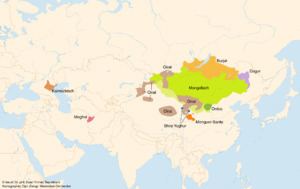Glottolog: mong1329 | ISO 639-5: xgn | |
 | ||
Geographicdistribution: Mongolia; Inner Mongolia and regions close to its border, Xinjiang, Gansu, Qinghai (China); Buryatia, Kalmykia (Russia) and Herat (Afghanistan) Linguistic classification: Khitan–Mongolic? (see below)Otherwise one of the world's primary language families Subdivisions: Central MongolicSouthern MongolicDaurMoghol | ||
Mongolian language all mongolic languages
The Mongolic languages are a group of languages spoken in East-Central Asia, mostly in Mongolia and surrounding areas plus in Kalmykia. The best-known member of this language family, Mongolian, is the primary language of most of the residents of Mongolia and the Mongolian residents of Inner Mongolia, China with an estimated 5.7+ million speakers.
Contents
The closest relative of the Mongolic languages appears to be the extinct language Khitan. Some linguists have grouped Mongolic with Turkic, Tungusic, and possibly Koreanic and Japonic as part of the controversial Altaic family, but this has been widely discredited.
Classification
Historical Mongolic:
Contemporary Mongolic:
The classification and speaker numbers above follow Janhunen (2006) except for Southern Mongolic which follows Nugteren (2011). In another classificational approach, there is a tendency to call Central Mongolian a language consisting of Mongolian proper, Oirat and Buryat, while Ordos (and implicitly also Khamnigan) is seen as a variety of Mongolian proper. Within Mongolian proper, they then draw a distinction between Khalkha on the one hand and Southern Mongolian (containing everything else) on the other hand. A less common subdivision of Central Mongolian is to divide it into a Central dialect (Khalkha, Chakhar, Ordos), an Eastern dialect (Kharchin, Khorchin), a Western dialect (Oirat, Kalmyk), and a Northern dialect (consisting of two Buryat varieties). The broader delimitation of Mongolian may be based on mutual intelligibility, but an analysis based on a tree diagram such as the one above faces other problems due to the close contacts between e.g. Buryat and Khalkha Mongols during history thus creating or preserving a dialect continuum. Another problem lies in the sheer comparability of terminology as Western linguists use language and dialect, while Mongolian linguists use the Grimmian trichotomy language (kele), dialect (nutuγ-un ayalγu) and Mundart (aman ayalγu).
Proto-Mongolic
Proto-Mongolic, the ancestor language of the modern Mongolic languages, is very close to Middle Mongol, the language spoken at the time of Genghis Khan and the Mongol Empire. Most features of modern Mongolic languages can thus be reconstructed from Middle Mongol. An exception would be the voice suffix like -caga- 'do together', which can be reconstructed from the modern languages but is not attested in Middle Mongol.
One can speculate that the languages of Donghu, Wuhuan, and Xianbei might be related to Proto-Mongolic. For Tabghach, the language of the founders of the Northern Wei dynasty for which the surviving evidence is very sparse, and Khitan, for which evidence exists that is written in the two Khitan scripts which have as yet not been fully deciphered, a direct affiliation to Mongolic can now be taken to be most likely or even demonstrated.
Para-Mongolic
The closest relative of the languages traced back to Proto-Mongolic appears to be the medieval Khitan language. Khitan has been described as "Para-Mongolic": not part of the Mongolic family, but related to it.
